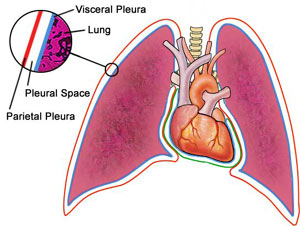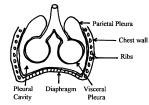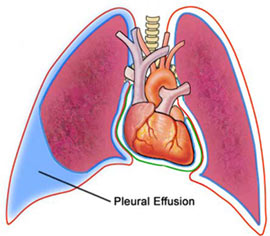- What is Pleural effusion
- Statistics on Pleural effusion
- Risk Factors for Pleural effusion
- Progression of Pleural effusion
- Symptoms of Pleural effusion
- Clinical Examination of Pleural effusion
- How is Pleural effusion Diagnosed?
- Prognosis of Pleural effusion
- How is Pleural effusion Treated?
- Pleural effusion References
What is Pleural effusion
A pleural effusion is a disease of the lung.
The pleura are thin films of connective tissue, which line both the outer surface of the lungs, and the inside of the chest cavity. The relationship of the pleura to the lungs and chest can be imagined as if the pleura were a balloon blown up inside the chest, into which the lungs have been pushed. Thus, there are in fact two layers of pleura between the outer surface of the lung and the chest wall. One is adherent to the lung, whereas the other layer follows the outline of the chest wall. The two layers press up against one another, and in the healthy chest, there is no air or significant fluid between them. In a pleural effusion, fluid is present in this potential space between the two layers of pleura.
This does not include pus in the pleural space (empyema) or blood (haemothorax).
Statistics on Pleural effusion
Pleural effusions are a very common phenomena, since they can be caused by any of a number of lung and heart disorders. A small pleural effusion is often present on a chest x-ray when somebody has a significant heart or lung problem.
Risk Factors for Pleural effusion
The following diseases may cause pleural effusion:
- Heart failure
- Bacterial pneumonia
- lung cancer and other tumours with lung metastases
- Pulmonary embolism
- Radiation therapy to the chest
- Nephrotic syndrome
- Hypothyroidism
- Ovarian tumours
- Tuberculosis
- Connective tissue disease (for example, rheumatoid arthritis, lupus)
- Rarely: heart attack, acute pancreatitis, mesothelioma, sarcoidosis, yellow-nail syndrome, familial Mediterranean fever.
Progression of Pleural effusion
The natural history of pleural effusions is largely determined by the cause. Pleural effusions as a result of a transient cause (e.g. pneumonia, infarction, exacerbation of heart failure) will reasorb. However if the cause is progressive (eg. mesothelioma or pulmonary metastases), then the effusion, even if drained will re-accumulate.
Large effusions will cause shortness of breath since they preclude the lung on that side from expanding adequately – they are often accompanied by a degree of collapse.
How is Pleural effusion Diagnosed?
- Chest x-ray can detect pleural effusion containing 300ml or more.
- Pleural effusions can be unilateral or bilateral – a large unilateral pleural effusion is more ominous since it can signify a malignancy.
- Diagnostic thoracentesis is a simple procedure involving sampling of the pleural fluid for analysis. It may be used to give clues to the cause of the effusion.
Prognosis of Pleural effusion
Massive effusion may be life threatening. Otherwise, the prognosis clearly depends on the underlying cause of effusion. Malignant pleural effusion may be recurrent.
How is Pleural effusion Treated?
- Large pleural effusions, causing severe breathlessness, are drained, by needle in an acute emergency, or otherwise by chest drain inserted under local anaesthetic.
- Malignant pleural effusions may be recurrent. They are treated by drainage, followed by the instillation of certain chemicals into the pleural space which help stick the two layers of pleura together, as to stop further fluid accumulating.
- Other effusions are treated by treating the underlying cause.
Pleural effusion References
- Braunwald, Fauci, Kasper, Hauser, Longo, Jameson. Harrison’s Principles of Internal Medicine. 16th Edition. McGraw-Hill. 2005.
- Cotran RS, Kumar V, Collins T. Robbins Pathological Basis of Disease Sixth Ed. WB Saunders Company 1999. pp749-751
- Kumar P, Clark M. Clinical Medicine. Fourth Ed. WB Saunders, 1998. p825
- Talley NJ, O’Connor S. Clinical examination. Third Ed. MacClennan & Petty, 1996. p120
All content and media on the HealthEngine Blog is created and published online for informational purposes only. It is not intended to be a substitute for professional medical advice and should not be relied on as health or personal advice. Always seek the guidance of your doctor or other qualified health professional with any questions you may have regarding your health or a medical condition. Never disregard the advice of a medical professional, or delay in seeking it because of something you have read on this Website. If you think you may have a medical emergency, call your doctor, go to the nearest hospital emergency department, or call the emergency services immediately.










